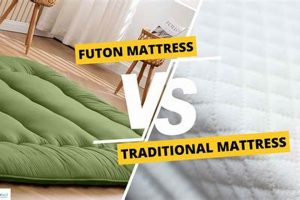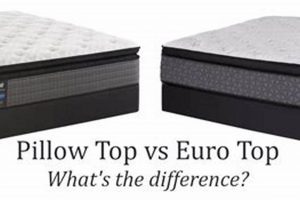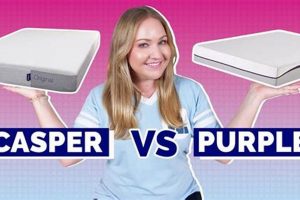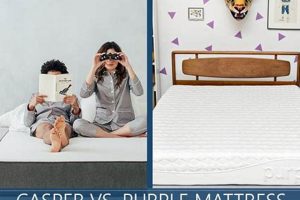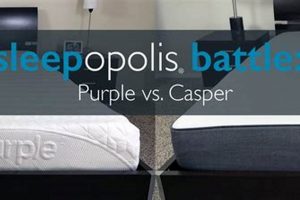The comparison of mattresses incorporating disparate core materials against those constructed primarily of viscoelastic foam is a frequent consideration for consumers seeking optimal sleep surfaces. This comparison focuses on factors such as support, temperature regulation, motion isolation, and overall durability.
The relevance of this evaluation stems from the diverse needs and preferences of individuals regarding sleep quality and physical well-being. A judicious selection process, informed by understanding the unique attributes of each mattress type, can significantly impact sleep comfort and long-term postural support. Historical context reveals an evolution of mattress technology driven by ongoing efforts to improve sleep quality and address common complaints associated with traditional innerspring designs.
A detailed examination of the construction, performance characteristics, and suitability for various sleep styles will provide a clearer understanding of the distinctions and advantages associated with each design.
Key Considerations When Choosing Between Disparate Mattress Constructions
Selecting an appropriate sleep surface necessitates careful consideration of individual needs and preferences. The following points offer guidance when evaluating options.
Tip 1: Assess Support Needs: Individuals requiring enhanced spinal alignment, particularly those with pre-existing back conditions, should carefully evaluate the support offered by each mattress. Hybrid models, often incorporating innerspring systems, may provide greater structural integrity compared to all-foam designs. Conversely, memory foam may offer superior contouring.
Tip 2: Evaluate Temperature Regulation: Thermal comfort is crucial for uninterrupted sleep. Memory foam can sometimes trap heat; therefore, individuals prone to night sweats should investigate hybrid options with enhanced airflow or memory foam infused with cooling gels or other temperature-regulating materials.
Tip 3: Consider Motion Isolation: If sharing a bed with a partner, motion isolation becomes a critical factor. Memory foam is typically superior at dampening movement transfer, minimizing disturbances caused by a partner’s tossing and turning. However, hybrid models with individually wrapped coils can also offer reasonable motion isolation.
Tip 4: Examine Edge Support: Strong edge support is advantageous for individuals who sit on the edge of the bed or require the full sleeping surface. Hybrid mattresses, owing to their reinforced perimeters, often exhibit better edge support than all-foam counterparts.
Tip 5: Investigate Durability and Longevity: The lifespan of a mattress represents a significant investment. Hybrid mattresses, with their combination of coil and foam components, can, depending on the quality of materials, offer enhanced durability compared to all-foam options. Evaluate the density of the foam and the gauge of the coils for a more accurate assessment.
Tip 6: Understand Firmness Levels: Firmness is a subjective measure, but it significantly influences sleep comfort. Both types are available in a spectrum of firmness options. Trialing different firmness levels is crucial to determine the most suitable choice based on individual comfort and support requirements.
Understanding these essential aspects is crucial for making an informed decision tailored to individual sleeping patterns and physical requirements.
The subsequent sections will explore specific applications and potential drawbacks associated with each mattress category in more detail.
1. Support and Alignment
Proper spinal alignment during sleep is a key determinant of sleep quality and musculoskeletal health. The contrasting construction of hybrid and memory foam mattresses directly impacts their ability to deliver adequate support and maintain this critical alignment.
- Coil System Contribution
In hybrid mattresses, the coil system functions as the primary support structure. The gauge and arrangement of the coils influence the mattress’s firmness and its capacity to resist compression under weight. A well-designed coil system can provide targeted support, conforming to the body’s curves and preventing excessive sinking, which could lead to spinal misalignment.
- Foam Layer Influence
Memory foam mattresses rely entirely on the foam layers for both support and contouring. The density and composition of the foam determine its firmness and its ability to distribute weight evenly. High-density memory foam offers greater support and resists compression better than low-density foam, contributing to improved spinal alignment.
- Spinal Zone Considerations
Some mattress designs incorporate zoned support, where different sections of the mattress are engineered with varying levels of firmness to accommodate different areas of the body. Hybrid and memory foam mattresses can both utilize zoned support systems to provide enhanced support to the lumbar region, promoting proper spinal alignment for a wider range of body types and sleep positions.
- Long-Term Support Degradation
Over time, both coil systems and foam layers can degrade, leading to a reduction in support and potential spinal misalignment. Coil systems may experience sagging, while foam layers can compress and lose their original density. Regular mattress rotation and the use of a supportive foundation can help to prolong the lifespan of both mattress types and maintain their support capabilities.
The interplay between coil system integrity, foam density, zonal support implementation, and degradation timelines dictates the effectiveness of both mattress types in achieving and sustaining optimal spinal alignment. Understanding these multifaceted influences provides consumers with a more nuanced basis for informed purchase decisions.
2. Temperature Regulation
Temperature regulation represents a critical aspect of sleep comfort, and the choice between hybrid and memory foam mattresses significantly impacts this factor. Memory foam, by its inherent structure, tends to retain heat due to limited airflow. This characteristic can lead to elevated sleeping temperatures, potentially disrupting sleep cycles and causing discomfort, especially for individuals prone to night sweats or those residing in warmer climates. The dense foam conforms closely to the body, reducing ventilation and trapping body heat. A practical example includes individuals experiencing restless nights, attributed to the mattress overheating, subsequently leading to fragmented sleep and diminished daytime performance.
Hybrid mattresses, in contrast, often incorporate coil systems that promote enhanced airflow. The open spaces between the coils facilitate ventilation, allowing heat to dissipate more effectively. Furthermore, some hybrid designs utilize breathable materials in the comfort layers, such as natural latex or open-cell memory foam, mitigating heat retention. As a result, hybrid mattresses generally offer better temperature regulation compared to traditional memory foam models. The effect is noticeable, particularly for individuals who are naturally warm sleepers or those living in humid environments, leading to a more comfortable and consistent sleep temperature throughout the night. For example, a hybrid mattress with individually wrapped coils and a breathable cover can significantly reduce overheating compared to a dense, all-foam mattress.
In summary, temperature regulation constitutes a key differentiator between hybrid and memory foam mattresses. While memory foam is appreciated for its pressure relief, its tendency to retain heat can present a significant challenge. Hybrid mattresses, with their coil systems and often breathable materials, typically provide superior temperature regulation. The optimal choice hinges on individual preferences and thermal comfort needs, emphasizing the importance of considering the mattress’s thermal properties alongside other factors such as support and motion isolation. Addressing temperature concerns is a critical step in selecting a mattress conducive to restful sleep.
3. Motion Isolation
Motion isolation is a critical consideration for individuals sharing a bed, as it minimizes sleep disturbances caused by a partner’s movements. The effectiveness of motion isolation differs significantly between hybrid and memory foam mattresses due to their distinct construction and material properties. The ability of a mattress to dampen or absorb movement determines the degree to which a sleeper is affected by the motion of another.
- Viscoelastic Foam Dampening
Memory foam mattresses excel at motion isolation due to the viscoelastic nature of the foam. This type of foam absorbs energy and limits the transfer of movement across the mattress surface. For example, if one partner gets out of bed, the motion is less likely to disturb the other partner sleeping on the opposite side. This characteristic makes memory foam a suitable choice for couples with different sleep schedules or restless sleepers.
- Coil System Transfer
Hybrid mattresses, which incorporate coil systems, can transmit motion more readily compared to all-foam mattresses. However, the extent of motion transfer depends on the type of coil system used. Individually wrapped or pocketed coils reduce motion transfer by allowing each coil to move independently, minimizing the ripple effect across the mattress. In contrast, interconnected coil systems are more likely to transfer motion, resulting in greater disturbance.
- Density and Thickness Influence
The density and thickness of the foam layers in both hybrid and memory foam mattresses also affect motion isolation. Denser foams and thicker comfort layers generally provide better motion isolation by absorbing more energy and preventing the transmission of movement. Mattresses with thinner comfort layers or less dense foams may exhibit greater motion transfer, regardless of whether they are hybrid or all-foam.
- Construction Combinations
Some hybrid mattresses combine individually wrapped coils with thick layers of memory foam to maximize motion isolation. This design aims to provide the support of a coil system while minimizing motion transfer through the use of viscoelastic foam. These hybrid designs can offer a compromise between the responsiveness of a coil mattress and the motion isolation of a memory foam mattress.
The choice between a hybrid and memory foam mattress regarding motion isolation hinges on the specific construction and materials used. While memory foam generally offers superior motion isolation, hybrid mattresses with individually wrapped coils and thick comfort layers can provide a reasonable level of motion dampening. The evaluation of motion isolation should consider the coil system, foam density, and overall mattress construction to determine the most suitable option for minimizing sleep disturbances.
4. Pressure Relief
Pressure relief is a critical factor in mattress selection, directly influencing sleep comfort and potentially alleviating pain associated with pressure points. The differing construction of hybrid and memory foam mattresses dictates their effectiveness in pressure relief.
- Conforming Ability of Memory Foam
Memory foam excels at pressure relief due to its ability to conform closely to the body’s contours. The viscoelastic properties of memory foam distribute weight evenly, reducing pressure on sensitive areas such as the shoulders, hips, and knees. This contouring effect minimizes pressure points, promoting better circulation and reducing discomfort for individuals with arthritis, fibromyalgia, or other conditions causing chronic pain. A practical example involves individuals experiencing reduced hip pain when sleeping on memory foam compared to a traditional innerspring mattress.
- Hybrid Mattress Pressure Distribution
Hybrid mattresses offer a different approach to pressure relief, combining the support of a coil system with comfort layers of foam, latex, or other materials. The coil system provides an underlying support structure, while the comfort layers offer cushioning and pressure distribution. The effectiveness of pressure relief in hybrid mattresses depends on the type and thickness of the comfort layers. Thicker comfort layers of memory foam or latex can provide significant pressure relief, while thinner layers may offer less contouring and pressure distribution.
- Zoned Pressure Relief Systems
Both hybrid and memory foam mattresses may incorporate zoned pressure relief systems, where different sections of the mattress are engineered with varying levels of firmness or contouring. These zoned systems target specific areas of the body, providing enhanced pressure relief to sensitive regions while offering greater support to other areas. For example, a mattress may feature softer foam in the shoulder and hip areas to alleviate pressure, while the lumbar region receives firmer support to maintain spinal alignment.
- Firmness Level Impact
The firmness level of both hybrid and memory foam mattresses significantly influences their pressure relief capabilities. Softer mattresses generally offer better pressure relief by allowing the body to sink deeper into the mattress and distributing weight more evenly. Firmer mattresses, while providing greater support, may exert more pressure on sensitive areas. The ideal firmness level for pressure relief depends on individual preferences, body weight, and sleep position. Lighter individuals and side sleepers typically benefit from softer mattresses, while heavier individuals and back sleepers may prefer firmer options.
The pressure relief characteristics of hybrid and memory foam mattresses are determined by their construction, materials, and firmness level. Memory foam generally provides superior contouring and pressure distribution, while hybrid mattresses offer a balance of support and pressure relief depending on their comfort layer composition. Individuals seeking optimal pressure relief should consider their specific needs and preferences when selecting between these mattress types. Evaluation of firmness, construction, and the presence of zoned pressure relief systems is essential for an informed decision.
5. Edge Support Stability
Edge support stability is a critical attribute in mattress performance, affecting usable sleep surface and ease of ingress and egress. The design variations between hybrid and memory foam mattresses significantly impact edge support, thereby influencing overall user satisfaction.
- Coil Reinforcement Systems
Hybrid mattresses often incorporate reinforced perimeters, utilizing thicker gauge coils or encasements of high-density foam to enhance edge support. This reinforcement prevents sagging and compression along the edges, maximizing the usable sleep surface and providing a stable platform for sitting or getting in and out of bed. For example, a hybrid mattress with reinforced edges may allow two individuals to sleep comfortably near the edge without feeling like they will roll off.
- Foam Density Limitations
Memory foam mattresses, lacking an internal coil structure, typically rely solely on foam density for edge support. High-density foams can offer some degree of edge support, but they are generally less effective than the reinforced perimeters found in hybrid models. Over time, the edges of memory foam mattresses may compress and soften, reducing the usable sleep surface and making it more difficult to sit comfortably on the edge of the bed. For instance, the edge of a memory foam mattress may gradually lose its firmness, making it less supportive for individuals who prefer to sit on the edge while dressing.
- Edge Collapse and Usable Surface
Insufficient edge support can lead to edge collapse, reducing the usable sleep surface and causing a feeling of instability. This issue is more prevalent in memory foam mattresses with lower density foams. Edge collapse not only limits the sleeping area but also makes it more challenging for individuals with mobility issues to get in and out of bed. Conversely, a hybrid mattress with strong edge support maintains its shape and provides a stable, consistent sleeping surface from edge to edge.
- Impact on Sleep Quality and Accessibility
Superior edge support contributes to improved sleep quality by allowing sleepers to utilize the full width of the mattress without fear of rolling off. It also enhances accessibility for individuals with mobility limitations, providing a firm and stable surface for sitting and transferring in and out of bed. The choice between a hybrid mattress with enhanced edge support and a memory foam mattress with less robust edge support can significantly impact daily living activities and overall sleep experience.
The relative stability of the sleep surface perimeter distinguishes hybrid and memory foam mattresses. Hybrid models, particularly those with reinforced edges, generally offer superior edge support compared to all-foam designs. This is a key factor influencing usability and accessibility.
6. Material Durability
Material durability constitutes a primary determinant of mattress lifespan and long-term performance. The inherent compositions of hybrid and memory foam mattresses result in divergent durability profiles, impacting consumer value and replacement cycles.
- Coil System Fatigue and Resilience
The coil system within a hybrid mattress provides foundational support, but its longevity is contingent upon the quality of steel used and the coil construction. Over time, coil fatigue can occur, leading to sagging and diminished support. The gauge of the steel and the tempering process employed in coil manufacturing directly influence its resistance to deformation. Encased or pocketed coil systems may exhibit enhanced durability due to reduced friction and stress concentration compared to interconnected coil designs. For example, a hybrid mattress utilizing high-gauge, individually wrapped coils may maintain its structural integrity for a longer period compared to one constructed with lower-gauge, interconnected coils.
- Foam Density and Compression Set
Memory foam mattresses rely heavily on foam density for support and pressure relief. High-density memory foam offers greater resistance to compression set, a phenomenon where the foam permanently loses its original thickness and resilience. Low-density foams are more susceptible to compression set, resulting in diminished support and reduced mattress lifespan. The long-term durability of a memory foam mattress is thus directly proportional to the quality and density of the foam used. A mattress constructed with high-density memory foam may retain its shape and support characteristics for several years, while one with low-density foam may exhibit significant sagging within a relatively short timeframe.
- Layer Adhesion and Delamination
Hybrid mattresses consist of multiple layers of disparate materials, including coils, foams, and textiles. The adhesion between these layers is critical for maintaining structural integrity. Delamination, or the separation of layers, can compromise support and comfort. High-quality adhesives and manufacturing processes are essential to prevent delamination and ensure long-term durability. For instance, a hybrid mattress manufactured with robust adhesives and secure stitching is less likely to experience layer separation compared to one assembled with inferior bonding techniques.
- Cover Fabric Wear and Tear
The cover fabric of both hybrid and memory foam mattresses is subject to wear and tear from friction, body oils, and environmental factors. Durable, tightly woven fabrics offer greater resistance to abrasion and staining, extending the lifespan of the mattress. Breathable fabrics also contribute to longevity by facilitating moisture dissipation, reducing the risk of mold and mildew growth. A mattress cover made of a durable, stain-resistant material will likely withstand daily use and maintain its appearance better than one constructed with a thinner, less resilient fabric.
Material durability distinguishes the long-term performance characteristics of hybrid and memory foam mattresses. The coil system, foam density, layer adhesion, and cover fabric each contribute to the overall lifespan of the product. Understanding these factors is vital for consumers seeking a durable and cost-effective sleep solution. Careful consideration of material quality and construction techniques can mitigate premature degradation and maximize the value of a mattress investment.
7. Cost Considerations
Financial implications constitute a significant aspect when evaluating sleep surface options. Disparities exist in the acquisition costs associated with hybrid and memory foam mattresses, reflecting variations in materials, construction complexity, and manufacturing processes. These financial factors must be weighed against expected lifespan, performance characteristics, and individual needs to determine overall value.
- Raw Material Expenses
Hybrid mattresses typically incorporate a wider range of raw materials, including steel coils, various foam types, and textile components. The sourcing and processing of these diverse materials can elevate manufacturing costs. Conversely, memory foam mattresses primarily utilize viscoelastic foam, simplifying the raw material procurement process. However, the density and composition of the foam significantly influence its cost, with higher-density foams generally commanding a premium. For example, the inclusion of individually wrapped coils and specialized comfort layers in a hybrid mattress contributes to higher production expenses compared to a basic memory foam model.
- Manufacturing Complexity
The assembly of hybrid mattresses involves intricate manufacturing processes due to the integration of multiple components. Precise alignment and secure bonding of coils, foams, and textiles necessitate specialized equipment and skilled labor, adding to production overhead. Memory foam mattress manufacturing is typically less complex, involving the molding or cutting of foam slabs and the application of a cover. This streamlined process can result in lower production costs. For instance, the automated assembly lines used in memory foam production contribute to efficiency and cost reduction compared to the manual steps involved in constructing hybrid mattresses.
- Lifespan and Replacement Frequency
The expected lifespan of a mattress directly impacts its long-term cost-effectiveness. While initial acquisition costs may vary, a more durable mattress requiring less frequent replacement can prove more economical over time. Hybrid mattresses, owing to their coil systems, may exhibit greater resistance to sagging and compression compared to low-density memory foam options. However, high-density memory foam mattresses can also offer extended lifespans. Careful evaluation of material quality and construction techniques is essential to assess the expected durability and long-term value of each mattress type. For example, investing in a well-constructed hybrid mattress with a 10-year warranty may be more cost-effective than repeatedly purchasing cheaper, less durable memory foam mattresses.
- Brand Reputation and Premium Features
Brand recognition and the inclusion of premium features, such as advanced cooling technologies or zoned support systems, can significantly influence mattress prices. Established brands with a reputation for quality and innovation often command higher prices. Similarly, mattresses incorporating specialized features designed to enhance comfort and performance may carry a premium. Consumers should carefully assess the value proposition of these premium features in relation to their individual needs and budget constraints. For instance, a mattress from a well-known brand with a reputation for durability may justify a higher price point, while a mattress with advanced cooling technology may be worth the investment for individuals prone to overheating during sleep.
The interplay between raw material expenses, manufacturing complexity, lifespan expectations, and brand influence dictates the financial landscape of mattress selection. The relative importance of these factors is highly individual, contingent on budgetary constraints, sleep preferences, and desired product longevity. A comprehensive cost-benefit analysis ensures an economically rational decision aligned with personal priorities.
Frequently Asked Questions
This section addresses common inquiries concerning the selection of suitable mattress types. The information provided aims to clarify distinctions between prevalent options and inform consumer decision-making.
Question 1: What distinguishes a hybrid mattress from a memory foam mattress?
A hybrid mattress integrates both coil support systems and foam layers, typically memory foam or latex, to provide a balance of support and comfort. Memory foam mattresses, conversely, are constructed primarily of viscoelastic foam, offering enhanced contouring and pressure relief.
Question 2: Does memory foam invariably retain more heat than hybrid designs?
Generally, memory foam possesses a greater propensity for heat retention due to its density and reduced airflow. However, modern memory foam formulations often incorporate cooling gels or open-cell structures to mitigate heat retention. Hybrid designs typically promote better airflow through the coil system, aiding in temperature regulation.
Question 3: Which mattress type is more effective at isolating motion?
Memory foam mattresses generally offer superior motion isolation due to the foam’s ability to absorb movement and limit transfer across the mattress surface. Hybrid mattresses with individually wrapped coils can also provide reasonable motion isolation, though typically less effectively than all-foam designs.
Question 4: What considerations are paramount when evaluating support and spinal alignment?
Individuals should assess the firmness and contouring capabilities of each mattress type. Hybrid mattresses, with their coil systems, often provide greater structural support. Memory foam mattresses excel at conforming to the body’s contours, potentially relieving pressure points and promoting spinal alignment, particularly for side sleepers.
Question 5: How does edge support vary between mattress types?
Hybrid mattresses frequently feature reinforced perimeters, enhancing edge support and maximizing the usable sleep surface. Memory foam mattresses often lack comparable edge support, potentially leading to compression and a reduced sleeping area near the edges.
Question 6: What factors influence the long-term durability of each mattress type?
The lifespan of hybrid mattresses depends on coil system quality and foam density. Memory foam durability is primarily contingent upon foam density and resistance to compression set. Proper maintenance, including regular rotation, can extend the lifespan of both mattress types.
The factors outlined above provide a foundation for informed evaluation. Careful assessment of individual needs and priorities remains paramount in selecting the optimal sleep surface.
The following sections will explore strategies for optimizing sleep hygiene and maximizing the benefits of a chosen mattress.
“hybrid mattress vs memory foam” Conclusion
The preceding exploration has detailed the key distinctions between hybrid and memory foam mattress designs. Factors examined include support characteristics, thermal regulation, motion isolation capabilities, pressure relief effectiveness, edge support stability, material durability, and relative cost considerations. Each aspect plays a crucial role in determining the suitability of a particular mattress for individual needs and preferences.
The optimization of sleep quality depends on the careful assessment of these attributes within the context of personal requirements and lifestyle considerations. Continued advancements in sleep technology and material science are expected to further refine mattress design and enhance the sleep experience. Therefore, ongoing research and informed consumer awareness remain essential for maximizing the potential benefits of any sleep surface investment.


